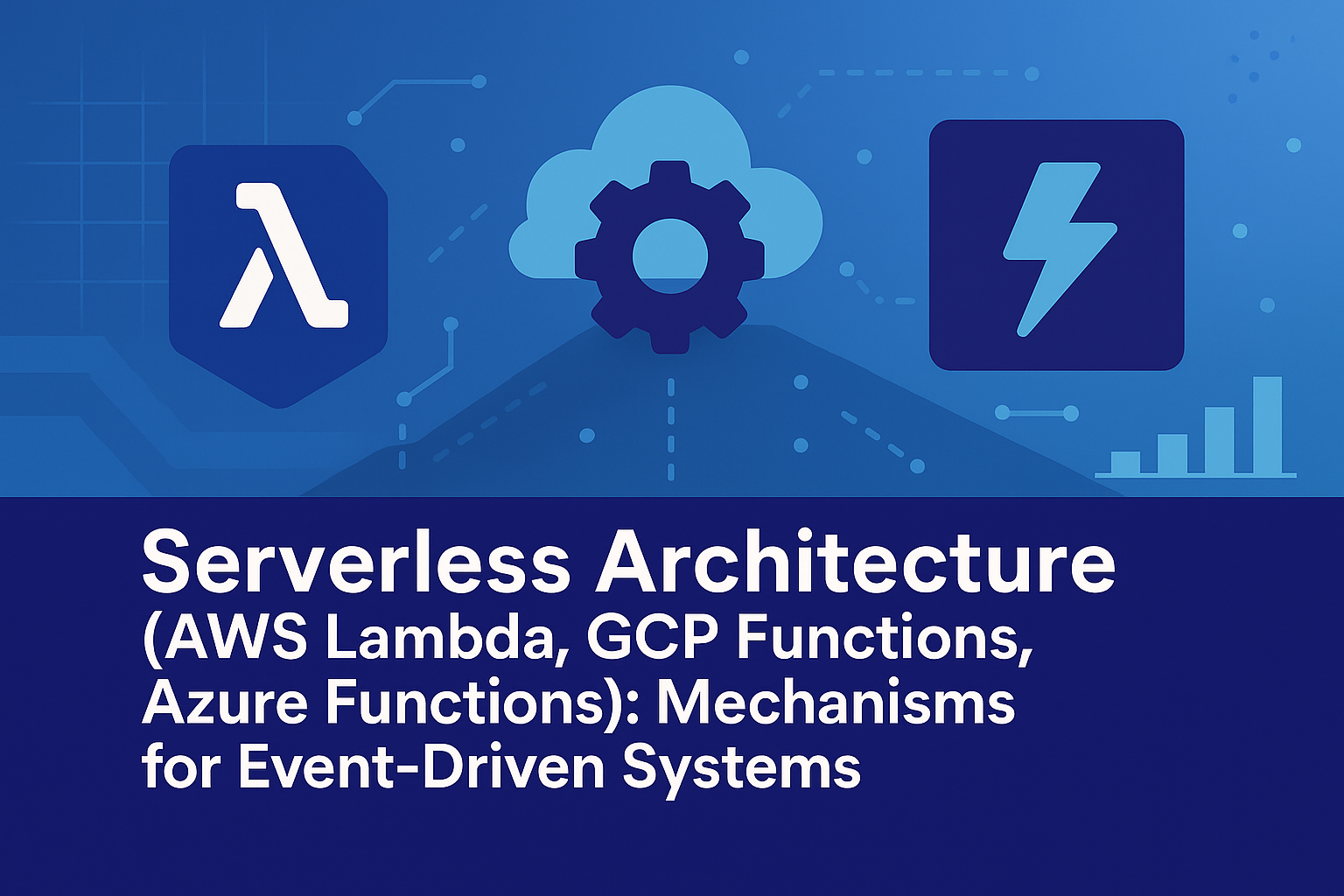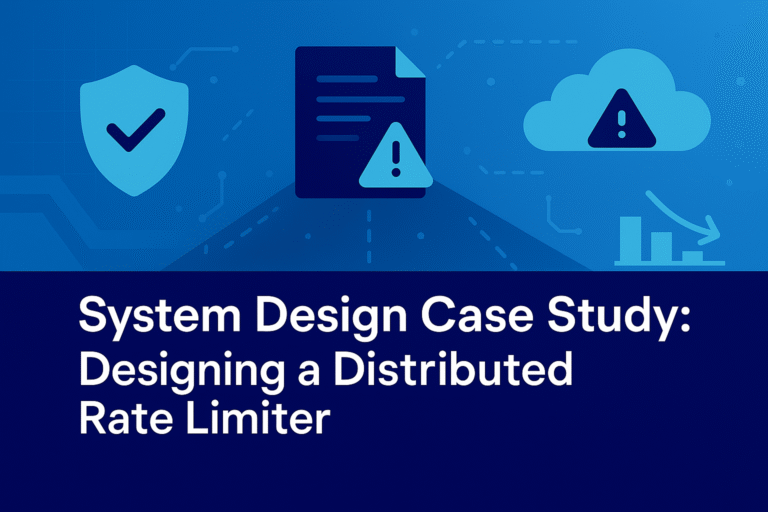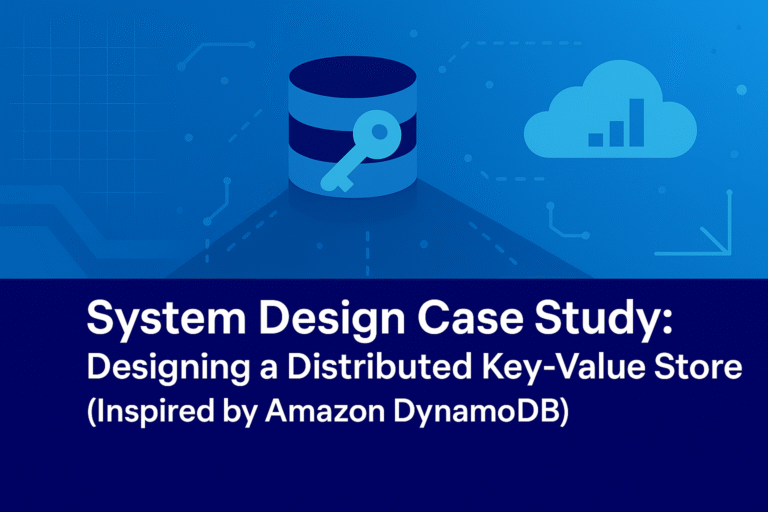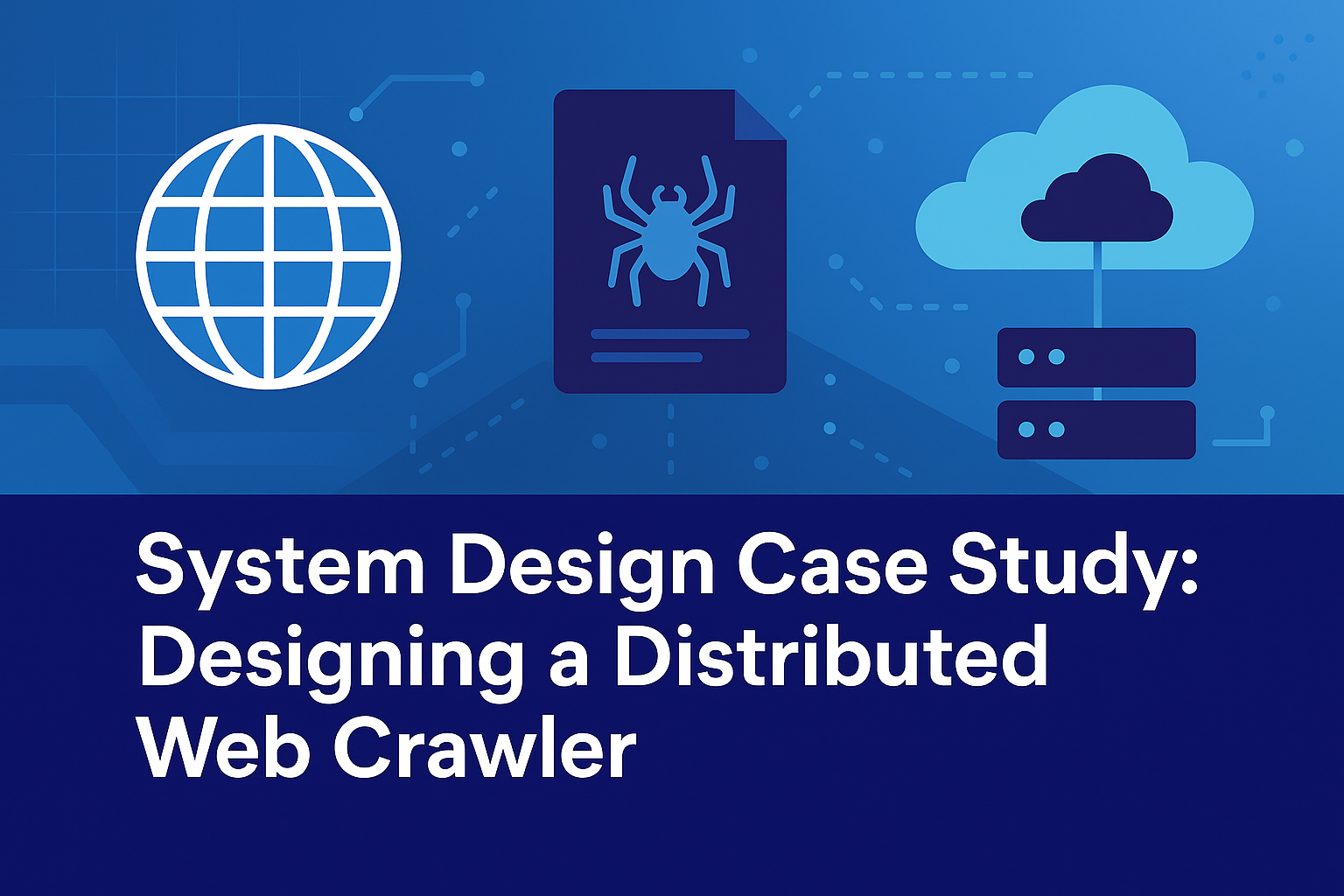Introduction
Serverless architecture represents a paradigm shift in cloud computing, where developers focus on writing code without managing underlying infrastructure. Serverless computing, exemplified by platforms like AWS Lambda, Google Cloud Functions (GCP Functions), and Azure Functions, enables event-driven systems that automatically scale, execute code in response to triggers, and charge only for actual usage. This approach aligns with cloud-native design, offering high scalability (e.g., 1M req/s), resilience (e.g., 99.999% uptime), and cost efficiency for applications like e-commerce platforms, financial systems, and IoT solutions. By abstracting server management, serverless architectures reduce operational overhead, making them ideal for event-driven workloads. This comprehensive analysis explores the mechanisms, implementation strategies, advantages, limitations, and trade-offs of serverless architecture, focusing on AWS Lambda, GCP Functions, and Azure Functions, with C# code examples as per your preference. It integrates foundational distributed systems concepts from your prior conversations, including the CAP Theorem, consistency models, consistent hashing, idempotency, unique IDs (e.g., Snowflake), heartbeats, failure handling, single points of failure (SPOFs), checksums, GeoHashing, rate limiting, Change Data Capture (CDC), load balancing, quorum consensus, multi-region deployments, capacity planning, backpressure handling, exactly-once vs. at-least-once semantics, event-driven architecture (EDA), microservices design, inter-service communication, data consistency, deployment strategies, testing strategies, Domain-Driven Design (DDD), API Gateway, Saga Pattern, Strangler Fig Pattern, Sidecar/Ambassador/Adapter Patterns, Resiliency Patterns, Service Mesh, Micro Frontends, API Versioning, Cloud-Native Design, Cloud Service Models, Containers vs. VMs, and Kubernetes Architecture & Scaling. Drawing on your interest in e-commerce integrations, API scalability, and resilient systems, this guide provides a structured framework for architects to leverage serverless computing for event-driven systems, ensuring alignment with business needs for scalability, resilience, and cost efficiency.
Core Principles of Serverless Architecture
Serverless architecture, often categorized under Function as a Service (FaaS) within cloud service models, enables developers to deploy code as individual functions that execute in response to events, with the cloud provider managing infrastructure, scaling, and availability.
- Key Principles:
- Event-Driven Execution: Functions are triggered by events (e.g., HTTP requests, queue messages, database changes).
- Automatic Scaling: Scales instantly with event volume (e.g., 1M events/s).
- Pay-Per-Use Pricing: Charges only for execution time (e.g., $0.0000167/GB-s).
- Statelessness: Functions are ephemeral, requiring external state management (e.g., DynamoDB, Redis).
- Resilience: Managed retries and dead-letter queues (DLQs), as per your failure handling query.
- Observability: Integrates with metrics (CloudWatch), tracing (X-Ray), and logging.
- Automation: Simplifies CI/CD with serverless frameworks (e.g., AWS SAM, Serverless Framework).
- Mathematical Foundation:
- Cost: Cost = invocations × cost_per_invocation + memory_seconds × cost_per_GB_s, e.g., 1M invocations × $0.0000002 + 1M GB-s × $0.0000167 = $0.20 + $16.70 = $16.90.
- Scalability: Throughput = events_per_second × function_concurrency, e.g., 1M events/s × 1 = 1M req/s.
- Latency: Latency = cold_start + execution_time, e.g., 100ms + 10ms = 110ms.
- Availability: Availability = provider_uptime, e.g., 99.999%.
- Integration with Prior Concepts:
- CAP Theorem: Prioritizes AP for availability, as per your CAP query.
- Consistency Models: Uses eventual consistency via CDC/EDA, as per your data consistency query.
- Consistent Hashing: Routes events, as per your load balancing query.
- Idempotency: Ensures safe retries (Snowflake IDs), as per your idempotency query.
- Failure Handling: Uses circuit breakers, retries, timeouts, DLQs, as per your Resiliency Patterns and failure handling queries.
- Heartbeats: Monitors function health (< 5s), as per your heartbeats query.
- SPOFs: Avoids via provider-managed replication, as per your SPOFs query.
- Checksums: Ensures data integrity (SHA-256), as per your checksums query.
- GeoHashing: Routes events by region, as per your GeoHashing query.
- Rate Limiting: Caps traffic (100,000 req/s), as per your rate limiting query.
- CDC: Syncs data, as per your data consistency query.
- Load Balancing: Managed by provider, as per your load balancing query.
- Multi-Region: Reduces latency (< 50ms), as per your multi-region query.
- Backpressure: Manages load via queues, as per your backpressure query.
- EDA: Core to serverless, as per your EDA query.
- Saga Pattern: Coordinates distributed transactions, as per your Saga query.
- DDD: Aligns functions with Bounded Contexts, as per your DDD query.
- API Gateway: Routes HTTP triggers, as per your API Gateway query.
- Strangler Fig: Supports migration, as per your Strangler Fig query.
- Service Mesh: Less relevant due to provider-managed networking, as per your Service Mesh query.
- Micro Frontends: Consumes APIs, as per your Micro Frontends query.
- API Versioning: Manages function APIs, as per your API Versioning query.
- Cloud-Native Design: Aligns with FaaS, as per your Cloud-Native Design query.
- Cloud Service Models: Serverless is FaaS, as per your Cloud Service Models query.
- Containers vs. VMs: Uses lightweight containers, as per your Containers vs. VMs query.
- Kubernetes Architecture & Scaling: Complements serverless for hybrid setups, as per your Kubernetes query.
Serverless Platforms: AWS Lambda, GCP Functions, Azure Functions
1. AWS Lambda
- Mechanisms:
- Triggers: HTTP (API Gateway), SQS, SNS, DynamoDB Streams, Kafka.
- Runtime: Supports C# (.NET Core), Python, Node.js, etc.
- Scaling: Automatic, up to 10,000 concurrent executions (configurable).
- Resilience: Managed retries, DLQs (SQS/SNS), timeouts (up to 15min).
- Observability: CloudWatch for metrics/logs, X-Ray for tracing.
- Deployment: AWS SAM, Serverless Framework.
- Key Features:
- Provisioned Concurrency for reduced cold starts.
- Lambda Layers for shared code.
- GeoHashing via API Gateway for regional routing.
- Rate limiting via API Gateway (100,000 req/s).
2. Google Cloud Functions (GCP Functions)
- Mechanisms:
- Triggers: HTTP, Pub/Sub, Cloud Storage, Firestore.
- Runtime: Supports C# (.NET Core), Python, Go, etc.
- Scaling: Automatic, with per-function concurrency limits.
- Resilience: Managed retries, timeouts (up to 9min).
- Observability: Cloud Monitoring for metrics, Cloud Trace for tracing.
- Deployment: gcloud CLI, Terraform.
- Key Features:
- Tight integration with GCP services (e.g., Pub/Sub).
- Event-driven processing for EDA.
- GeoHashing via Cloud Load Balancing.
3. Azure Functions
- Mechanisms:
- Triggers: HTTP, Service Bus, Cosmos DB, Blob Storage.
- Runtime: Supports C# (.NET Core), Python, JavaScript, etc.
- Scaling: Automatic, with Consumption or Premium plans.
- Resilience: Managed retries, DLQs (Service Bus), timeouts (up to 10min, extendable in Premium).
- Observability: Application Insights for metrics/tracing.
- Deployment: Azure CLI, Visual Studio.
- Key Features:
- Durable Functions for stateful workflows (e.g., Saga Pattern).
- Premium Plan for VNet integration and reduced cold starts.
- GeoHashing via Azure Traffic Manager.
Detailed Analysis
Advantages
- Zero Server Management: Fully managed infrastructure reduces DevOps effort by 50%.
- Cost Efficiency: Pay-per-use pricing (e.g., $16.90 for 1M invocations).
- Scalability: Instant scaling for event-driven workloads (1M req/s).
- Resilience: Managed retries, DLQs, and high availability (99.999%).
- Agility: Rapid deployment with serverless frameworks (e.g., AWS SAM).
- Event-Driven Fit: Aligns with EDA, as per your EDA query.
Limitations
- Cold Start Latency: Initial invocation delays (100–500ms).
- Statelessness: Requires external storage (e.g., DynamoDB) for state.
- Execution Limits: Timeouts (e.g., 15min in Lambda) and resource constraints.
- Vendor Lock-In: Dependency on provider-specific APIs.
- Debugging Complexity: Distributed tracing needed for debugging.
Trade-Offs
- Scalability vs. Cold Starts:
- Trade-Off: Instant scaling but cold starts add latency (100–500ms).
- Decision: Use serverless for sporadic workloads, containers for low-latency needs.
- Interview Strategy: Propose Lambda for IoT, Kubernetes for e-commerce.
- Cost vs. Control:
- Trade-Off: Pay-per-use is cost-efficient but limits control over infrastructure.
- Decision: Use serverless for cost-sensitive apps, IaaS for custom setups.
- Interview Strategy: Highlight serverless for startups, IaaS for banking.
- Simplicity vs. Flexibility:
- Trade-Off: Serverless simplifies operations but restricts customization.
- Decision: Use serverless for event-driven tasks, PaaS for microservices.
- Interview Strategy: Propose serverless for analytics, PaaS for web apps.
- Consistency vs. Availability:
- Trade-Off: Eventual consistency via EDA ensures availability, as per your CAP query.
- Decision: Use EDA for non-critical data, strong consistency for critical.
- Interview Strategy: Propose EDA for e-commerce, strong consistency for finance.
Integration with Prior Concepts
- CAP Theorem: Prioritizes AP, as per your CAP query.
- Consistency Models: Uses eventual consistency via CDC/EDA, as per your data consistency query.
- Consistent Hashing: Routes events, as per your load balancing query.
- Idempotency: Ensures safe retries (Snowflake IDs), as per your idempotency query.
- Failure Handling: Uses retries, timeouts, DLQs, as per your Resiliency Patterns query.
- Heartbeats: Monitors function health (< 5s), as per your heartbeats query.
- SPOFs: Avoids via provider replication, as per your SPOFs query.
- Checksums: Ensures data integrity (SHA-256), as per your checksums query.
- GeoHashing: Routes events by region, as per your GeoHashing query.
- Rate Limiting: Caps traffic (100,000 req/s), as per your rate limiting query.
- CDC: Syncs data, as per your data consistency query.
- Load Balancing: Managed by provider, as per your load balancing query.
- Multi-Region: Reduces latency (< 50ms), as per your multi-region query.
- Backpressure: Manages load via queues, as per your backpressure query.
- EDA: Core to serverless, as per your EDA query.
- Saga Pattern: Coordinates transactions (e.g., Durable Functions), as per your Saga query.
- DDD: Aligns functions with Bounded Contexts, as per your DDD query.
- API Gateway: Routes HTTP triggers, as per your API Gateway query.
- Strangler Fig: Supports migration, as per your Strangler Fig query.
- Service Mesh: Less relevant, as per your Service Mesh query.
- Micro Frontends: Consumes APIs, as per your Micro Frontends query.
- API Versioning: Manages function APIs, as per your API Versioning query.
- Cloud-Native Design: Aligns with FaaS, as per your Cloud-Native Design query.
- Cloud Service Models: Serverless is FaaS, as per your Cloud Service Models query.
- Containers vs. VMs: Uses lightweight containers, as per your Containers vs. VMs query.
- Kubernetes: Complements serverless for hybrid setups, as per your Kubernetes query.
Real-World Use Cases
1. E-Commerce Platform (AWS Lambda)
- Context: An e-commerce platform (e.g., Shopify integration, as per your query) processes 100,000 orders/day, needing cost-efficient event processing.
- Implementation:
- AWS Lambda: Processes order events triggered by SQS or API Gateway.
- EDA: Kafka for order events, CDC for data sync.
- API Gateway: Routes HTTP requests with rate limiting (100,000 req/s) and API Versioning (/v1/orders).
- Resiliency: Managed retries, DLQs (SQS).
- Micro Frontends: React-based UI, as per your Micro Frontends query.
- Metrics: < 110ms latency (incl. cold starts), 100,000 req/s, 99.999% uptime.
- Trade-Off: Cost efficiency with cold start latency.
- Strategic Value: Handles sporadic order spikes cost-effectively.
2. Financial Transaction System (Azure Functions)
- Context: A banking system processes 500,000 transactions/day, requiring stateful workflows, as per your tagging system query.
- Implementation:
- Azure Functions: Durable Functions for Saga Pattern to coordinate transactions.
- Triggers: Service Bus for transaction events.
- Resiliency: Managed retries, DLQs (Service Bus).
- Observability: Application Insights for metrics/tracing.
- Metrics: < 120ms latency, 10,000 tx/s, 99.99% uptime.
- Trade-Off: Workflow flexibility with cold start overhead.
- Strategic Value: Ensures reliable transaction processing.
3. IoT Sensor Platform (GCP Functions)
- Context: A smart city processes 1M sensor readings/s, needing real-time analytics, as per your EDA query.
- Implementation:
- GCP Functions: Processes sensor data triggered by Pub/Sub.
- EDA: Pub/Sub for data ingestion, GeoHashing for regional routing.
- Resiliency: Managed retries, timeouts.
- Micro Frontends: Svelte-based dashboard, as per your Micro Frontends query.
- Metrics: < 110ms latency, 1M req/s, 99.999% uptime.
- Trade-Off: Scalability with statelessness complexity.
- Strategic Value: Cost-efficient real-time analytics.
Implementation Guide
// AWS Lambda: Order Processing Function
using Amazon.Lambda.Core;
using Amazon.Lambda.SQSEvents;
using Confluent.Kafka;
using System.Text.Json;
public class OrderProcessor
{
private readonly IProducer<Null, string> _kafkaProducer;
public OrderProcessor()
{
var config = new ProducerConfig { BootstrapServers = Environment.GetEnvironmentVariable("KAFKA_BOOTSTRAP_SERVERS") };
_kafkaProducer = new ProducerBuilder<Null, string>(config).Build();
}
[LambdaSerializer(typeof(Amazon.Lambda.Serialization.SystemTextJson.DefaultLambdaJsonSerializer))]
public async Task ProcessOrderAsync(SQSEvent sqsEvent, ILambdaContext context)
{
foreach (var record in sqsEvent.Records)
{
var order = JsonSerializer.Deserialize<Order>(record.Body);
if (order == null) continue;
// Idempotency check
var requestId = Guid.NewGuid().ToString(); // Snowflake ID
if (await IsProcessedAsync(requestId)) continue;
// Process order (simulated)
await Task.Delay(10); // Simulate work
// Publish confirmation event
var @event = new OrderConfirmedEvent
{
EventId = requestId,
OrderId = order.OrderId,
Status = "Confirmed"
};
await _kafkaProducer.ProduceAsync("order-confirmations", new Message<Null, string>
{
Value = JsonSerializer.Serialize(@event)
});
}
}
private async Task<bool> IsProcessedAsync(string requestId)
{
// Simulated idempotency check (e.g., DynamoDB)
return await Task.FromResult(false);
}
}
public class Order
{
public string OrderId { get; set; }
public double Amount { get; set; }
}
public class OrderConfirmedEvent
{
public string EventId { get; set; }
public string OrderId { get; set; }
public string Status { get; set; }
}
// Azure Functions: Durable Function for Saga Pattern
using Microsoft.Azure.WebJobs;
using Microsoft.Azure.WebJobs.Extensions.DurableTask;
using System.Threading.Tasks;
public static class OrderOrchestrator
{
[FunctionName("OrderOrchestrator")]
public static async Task RunOrchestrator(
[OrchestrationTrigger] IDurableOrchestrationContext context)
{
var order = context.GetInput<Order>();
var requestId = context.InstanceId; // Snowflake ID
// Idempotency check
if (await context.CallActivityAsync<bool>("CheckProcessed", requestId)) return;
// Saga Pattern: Coordinate payment and inventory
var paymentResult = await context.CallActivityAsync<bool>("ProcessPayment", order);
if (!paymentResult) throw new Exception("Payment failed");
var inventoryResult = await context.CallActivityAsync<bool>("ReserveInventory", order);
if (!inventoryResult)
{
// Compensating transaction
await context.CallActivityAsync("CancelPayment", order);
throw new Exception("Inventory reservation failed");
}
await context.CallActivityAsync("PublishOrderEvent", order);
}
[FunctionName("CheckProcessed")]
public static async Task<bool> CheckProcessed([ActivityTrigger] string requestId)
{
// Simulated idempotency check
return await Task.FromResult(false);
}
[FunctionName("ProcessPayment")]
public static async Task<bool> ProcessPayment([ActivityTrigger] Order order)
{
// Simulate payment processing
await Task.Delay(10);
return true;
}
[FunctionName("ReserveInventory")]
public static async Task<bool> ReserveInventory([ActivityTrigger] Order order)
{
// Simulate inventory reservation
await Task.Delay(10);
return true;
}
[FunctionName("CancelPayment")]
public static async Task CancelPayment([ActivityTrigger] Order order)
{
// Simulate payment cancellation
await Task.Delay(10);
}
[FunctionName("PublishOrderEvent")]
public static async Task PublishOrderEvent([ActivityTrigger] Order order)
{
// Simulate event publishing to Kafka
await Task.Delay(10);
}
}serverless.yml for AWS Lambda
service: order-processor
provider:
name: aws
runtime: dotnetcore3.1
functions:
processOrder:
handler: OrderProcessor::OrderProcessor.ProcessOrderAsync
events:
- sqs:
arn: arn:aws:sqs:us-east-1:123456789012:order-queue
environment:
KAFKA_BOOTSTRAP_SERVERS: kafka:9092
resources:
Resources:
OrderDLQ:
Type: AWS::SQS::Queue
Properties:
QueueName: order-dlq
// docker-compose.yml (for local testing)
version: '3.8'
services:
kafka:
image: confluentinc/cp-kafka:latest
environment:
- KAFKA_NUM_PARTITIONS=20
- KAFKA_REPLICATION_FACTOR=3
- KAFKA_RETENTION_MS=604800000
redis:
image: redis:latest
prometheus:
image: prom/prometheus:latest
jaeger:
image: jaegertracing/all-in-one:latestImplementation Details
- AWS Lambda:
- Processes order events from SQS, publishes to Kafka for EDA/CDC.
- Idempotency with Snowflake IDs, DLQs for failed events.
- API Gateway for HTTP triggers with rate limiting (100,000 req/s) and API Versioning (/v1/orders).
- Metrics: < 110ms latency, 100,000 req/s, 99.999% uptime.
- Azure Functions:
- Uses Durable Functions for Saga Pattern to coordinate transactions.
- Triggers via Service Bus, DLQs for resilience.
- Application Insights for observability.
- Metrics: < 120ms latency, 10,000 tx/s, 99.99% uptime.
- GCP Functions:
- Processes sensor data via Pub/Sub, uses GeoHashing for routing.
- Cloud Monitoring/Trace for observability.
- Metrics: < 110ms latency, 1M req/s, 99.999% uptime.
- Resiliency:
- Managed retries, DLQs, timeouts (500ms).
- Observability:
- CloudWatch/Application Insights/Cloud Monitoring for metrics (latency < 110ms, throughput 100,000 req/s, errors < 0.1%).
- X-Ray/Cloud Trace for tracing.
- Security:
- IAM roles, OAuth 2.0, SHA-256 checksums, as per your checksums query.
- CI/CD:
- AWS SAM/Azure CLI for deployments, supporting Blue-Green/Canary, as per your deployment query.
- Testing:
- Unit tests (xUnit, Moq), integration tests (Testcontainers), contract tests (Pact), as per your testing query.
Advanced Implementation Considerations
- Performance Optimization:
- Reduce cold starts with Provisioned Concurrency (AWS) or Premium Plan (Azure).
- Cache responses in Redis (< 0.5ms).
- Optimize function code (e.g., minimal dependencies).
- Scalability:
- Auto-scale functions for 1M req/s.
- Use queues (SQS, Service Bus, Pub/Sub) for backpressure.
- Resilience:
- Implement managed retries, DLQs, timeouts.
- Monitor health with heartbeats (< 5s).
- Observability:
- Track SLIs: latency (< 110ms), throughput (100,000 req/s), availability (99.999%).
- Alert on anomalies (> 0.1% errors) via CloudWatch.
- Security:
- Use least-privilege IAM roles.
- Rotate credentials every 24h.
- Testing:
- Stress-test with JMeter (1M req/s).
- Validate resilience with Chaos Monkey (< 5s recovery).
- Test contracts with Pact Broker.
- Multi-Region:
- Deploy functions per region for low latency (< 50ms).
- Use GeoHashing for routing.
Discussing in System Design Interviews
- Clarify Requirements:
- Ask: “What’s the workload (1M req/s)? Event-driven or continuous? Budget constraints?”
- Example: Confirm IoT needing real-time processing, e-commerce requiring cost efficiency.
- Propose Strategy:
- Suggest Lambda for event-driven tasks, Azure Functions for stateful workflows, Kubernetes for low-latency needs.
- Example: “Use Lambda for IoT, Durable Functions for banking.”
- Address Trade-Offs:
- Explain: “Serverless is cost-efficient but has cold starts; Kubernetes offers low latency but adds complexity.”
- Example: “Lambda for sporadic traffic, Kubernetes for steady loads.”
- Optimize and Monitor:
- Propose: “Optimize with Provisioned Concurrency, monitor with CloudWatch.”
- Example: “Track latency to ensure < 110ms.”
- Handle Edge Cases:
- Discuss: “Use DLQs for failed events, retries for resilience, IAM for security.”
- Example: “Route failed events to DLQs in e-commerce.”
- Iterate Based on Feedback:
- Adapt: “If cost is key, use serverless; if latency, use Kubernetes.”
- Example: “Simplify with serverless for startups.”
Conclusion
Serverless architecture, through AWS Lambda, GCP Functions, and Azure Functions, enables scalable, resilient, and cost-efficient event-driven systems. By leveraging EDA, Saga Pattern, DDD, API Gateway, API Versioning, Cloud-Native Design, Cloud Service Models, Containers vs. VMs, and Kubernetes (from your prior queries), serverless platforms support high-throughput (1M req/s) and high-availability (99.999%) applications. The C# implementation demonstrates their application in an e-commerce platform, using Lambda for event processing and Durable Functions for transaction coordination. Architects can use serverless for dynamic, event-driven workloads like IoT and e-commerce, complementing Kubernetes for low-latency needs, ensuring performance, resilience, and cost efficiency.




